Looking for the best SQ Phono LCR schematic, attached all schematics that I got it surfing the net.
Attachments
-
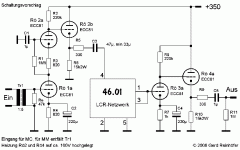 Reinhöfer LCR phono stage.gif15.6 KB · Views: 2,707
Reinhöfer LCR phono stage.gif15.6 KB · Views: 2,707 -
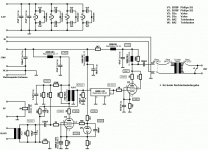 PhonoV phono stage.gif62.4 KB · Views: 2,688
PhonoV phono stage.gif62.4 KB · Views: 2,688 -
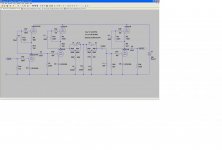 naz_420 phono stage.jpg44.8 KB · Views: 2,613
naz_420 phono stage.jpg44.8 KB · Views: 2,613 -
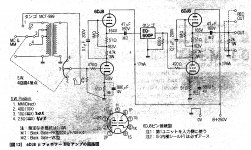 LS3-5A LCR PHONO STAGE.jpg646.3 KB · Views: 3,066
LS3-5A LCR PHONO STAGE.jpg646.3 KB · Views: 3,066 -
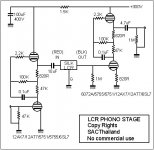 SACT Transformer_LCR3 PHONO STAGE.jpg41.6 KB · Views: 2,476
SACT Transformer_LCR3 PHONO STAGE.jpg41.6 KB · Views: 2,476 -
 TANGO LCR phono stage.jpg37.9 KB · Views: 1,639
TANGO LCR phono stage.jpg37.9 KB · Views: 1,639 -
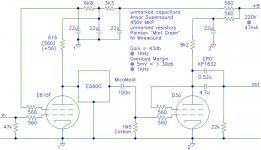 Torsten Loesch LCR600 phono stage.jpg78.3 KB · Views: 1,634
Torsten Loesch LCR600 phono stage.jpg78.3 KB · Views: 1,634 -
 TUNDERSTONE AUDIO LCR Phono Equaliser Schematic.gif13.9 KB · Views: 1,736
TUNDERSTONE AUDIO LCR Phono Equaliser Schematic.gif13.9 KB · Views: 1,736
Last edited:
Places that I know where to buy the filter chokes for LCR RIAA:
600R
passive RIAA LCR unit
600R
LCR-RIAA
600R
MOVING COIL CARTRIDGE STEP UP TRANSFORMERS
600R & 10K
SACThailand
Lundahl make LL4611 filter choke 1.8H & 0.18H but I can't see where to buy.
600R
passive RIAA LCR unit
600R
LCR-RIAA
600R
MOVING COIL CARTRIDGE STEP UP TRANSFORMERS
600R & 10K
SACThailand
Lundahl make LL4611 filter choke 1.8H & 0.18H but I can't see where to buy.
I'm sorry I can't see the price.
The Sowters seem very good value. There I said it.
I have no connection but have used some of their output transformers and a step up input transformer. Truly excellent and they provide real world specifications. Drop them a mail.
Got to be honest though whilst the build quality and materials used are perfect they do look somewhat utilitarian. Doesn't bother me as performance is worth more than some flashy gold terminals and a can full of magic goop.
Been thinking of an LCR phono with a planar triode such as 7077 on the input myself.
Cheers
Matt
I have no connection but have used some of their output transformers and a step up input transformer. Truly excellent and they provide real world specifications. Drop them a mail.
Got to be honest though whilst the build quality and materials used are perfect they do look somewhat utilitarian. Doesn't bother me as performance is worth more than some flashy gold terminals and a can full of magic goop.
Been thinking of an LCR phono with a planar triode such as 7077 on the input myself.
Cheers
Matt
I'm sorry I can't see the price.
Maybe you should ask for a quote from them, it's also advertised here
Lundahl make LL4611 filter choke 1.8H & 0.18H but I can't see where to buy.
Ask Benny Glass at DiyParadiso or Kevin Carter at K&K Audio.
Hello,
When I am back home in will send you the schematic of the Pultec pc10. Not sure you can find it on the Internet. There have been some publications about it in France.
Kind greetings, Eduard
When I am back home in will send you the schematic of the Pultec pc10. Not sure you can find it on the Internet. There have been some publications about it in France.
Kind greetings, Eduard
Ask Benny Glass at DiyParadiso or Kevin Carter at K&K Audio.
DiyParadiso still working?
K&K Audio without prices.
200$ x4
Answer from Dave Slagle to my email asking prices:
"The inductor set is $500 and the design also uses two nickel 1:1 transformers which are $500 so you are at $1500 for the inductors / transformers."
High gain pentode (trioded pentode: D3a, E810F, E280F, E180F, C3g etc.) as first tube (triode has high Miller capacitance);
Low output impedance driver (xxk:600R transformer, or DC coupled -mostly CF- tube with good coupling capacitor);
600R LCR modul;
High gain amplifier tube (with step down transformer or good coupling capacitor).
Overall gain 40dB or more (MM phono).
For example:
first stage 30-40dB;
LCR -20dB;
Output 30-40dB.
Low output impedance driver (xxk:600R transformer, or DC coupled -mostly CF- tube with good coupling capacitor);
600R LCR modul;
High gain amplifier tube (with step down transformer or good coupling capacitor).
Overall gain 40dB or more (MM phono).
For example:
first stage 30-40dB;
LCR -20dB;
Output 30-40dB.
Last edited:
Not to add yet another schematic, sufficing with my own experience.
Most phono stages are rather over-designed in view of what is desired; too many tubes. My own preference is for a feedback RIAA circuit, as in a double triode or even pentode-triode with the network between output anode and input cathode. Said before, this also has the possibility of providing a handy low-cut characteristic below say 25 Hz with no extra components - simply using the present resistors and capacitors to do that job. (With the added gain at low frequencies; products below say 25Hz have no business anyway in being in an RIAA circuit, throwing operating points about.)
I do not see what advantage there is in an LRC-configuration instead simply an R.C network (pardon me for being allergic to hum-picking up inductors in such circuits).
Most phono stages are rather over-designed in view of what is desired; too many tubes. My own preference is for a feedback RIAA circuit, as in a double triode or even pentode-triode with the network between output anode and input cathode. Said before, this also has the possibility of providing a handy low-cut characteristic below say 25 Hz with no extra components - simply using the present resistors and capacitors to do that job. (With the added gain at low frequencies; products below say 25Hz have no business anyway in being in an RIAA circuit, throwing operating points about.)
I do not see what advantage there is in an LRC-configuration instead simply an R.C network (pardon me for being allergic to hum-picking up inductors in such circuits).
Hello,
You should find the publications by the French which will explain why lcr is the way to go.
Number 39 published in 1986 I have the magazine itself at home but it can be found on the Internet.
The lcr technique is the one usually used by the companies making the records in the past.
Jean Hiragana explains very well why lcr is superior.
It is expensive to make but once it is well done it is perfect.
Ronaldo Bassi did write about the pulled pc10 in another French magazine. At that time there was a group which did build several of these pultecs. I even did write to lundahl if they could make the twocoils but they wouldn't.
Tango was still available then but even in Japan it was expensive.
Still have them in the attic.
Greetings, eduard
Prampli phono correction passive LCR (J.Hiraga)
Sorry it is in french
You should find the publications by the French which will explain why lcr is the way to go.
Number 39 published in 1986 I have the magazine itself at home but it can be found on the Internet.
The lcr technique is the one usually used by the companies making the records in the past.
Jean Hiragana explains very well why lcr is superior.
It is expensive to make but once it is well done it is perfect.
Ronaldo Bassi did write about the pulled pc10 in another French magazine. At that time there was a group which did build several of these pultecs. I even did write to lundahl if they could make the twocoils but they wouldn't.
Tango was still available then but even in Japan it was expensive.
Still have them in the attic.
Greetings, eduard
Prampli phono correction passive LCR (J.Hiraga)
Sorry it is in french
High gain pentode (trioded pentode: D3a, E810F, E280F, E180F, C3g etc.) as first tube (triode has high Miller capacitance);
Low output impedance driver (xxk:600R transformer, or DC coupled -mostly CF- tube with good coupling capacitor);
600R LCR modul;
High gain amplifier tube (with step down transformer or good coupling capacitor).
Overall gain 40dB or more (MM phono).
For example:
first stage 30-40dB;
LCR -20dB;
Output 30-40dB.
Do you have a schematic for DC coupled CF with output cap?
- Home
- Source & Line
- Analogue Source
- Looking for the best SQ Phono LCR schematic